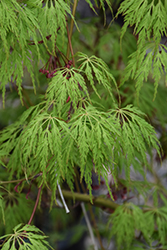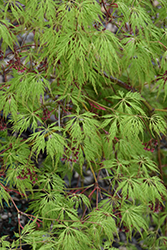It's all about ...
plants

Height: 7 feet
Spread: 10 feet
Sunlight:
![]()
![]()
Hardiness Zone: 6a
Other Names: Acer x pseudosieboldianum
Group/Class: Pacific Rim Collection
Brand: Iseli Nursery
Description:
A stunning, small landscape accent tree with an irregular, gently cascading habit; upright clusters of bright red seeds in spring; deep green, finely divided leaves in summer change to glorious shades of red, orange, and yellow in fall
Ornamental Features
Wabi Sabi Maple is primarily valued in the landscape or garden for its cascading habit of growth. It has attractive dark green deciduous foliage which emerges light green in spring. The deeply cut lobed palmate leaves are highly ornamental and turn outstanding shades of orange, red and yellow in the fall. The red fruits are held in clusters in early spring. The rough gray bark and brick red branches add an interesting dimension to the landscape.
Landscape Attributes
Wabi Sabi Maple is a spreading deciduous shrub with a shapely form and gracefully arching branches. It lends an extremely fine and delicate texture to the landscape composition which can make it a great accent feature on this basis alone.
This is a relatively low maintenance shrub, and should only be pruned in summer after the leaves have fully developed, as it may 'bleed' sap if pruned in late winter or early spring. It has no significant negative characteristics.
Wabi Sabi Maple is recommended for the following landscape applications;
- Accent
- Mass Planting
- Hedges/Screening
- General Garden Use
Planting & Growing
Wabi Sabi Maple will grow to be about 7 feet tall at maturity, with a spread of 10 feet. It has a low canopy with a typical clearance of 1 foot from the ground, and is suitable for planting under power lines. It grows at a slow rate, and under ideal conditions can be expected to live for 80 years or more.
This shrub does best in full sun to partial shade. It prefers to grow in average to moist conditions, and shouldn't be allowed to dry out. This plant will benefit from an application of bonemeal and/or mycorrhizal fertilizer at the time of planting. It is particular about its soil conditions, with a strong preference for rich, acidic soils. It is somewhat tolerant of urban pollution, and will benefit from being planted in a relatively sheltered location. Consider applying a thick mulch around the root zone in winter to protect it in exposed locations or colder microclimates. This particular variety is an interspecific hybrid.
This plant is not reliably hardy in our region, and certain restrictions may apply; contact the store for more information.

